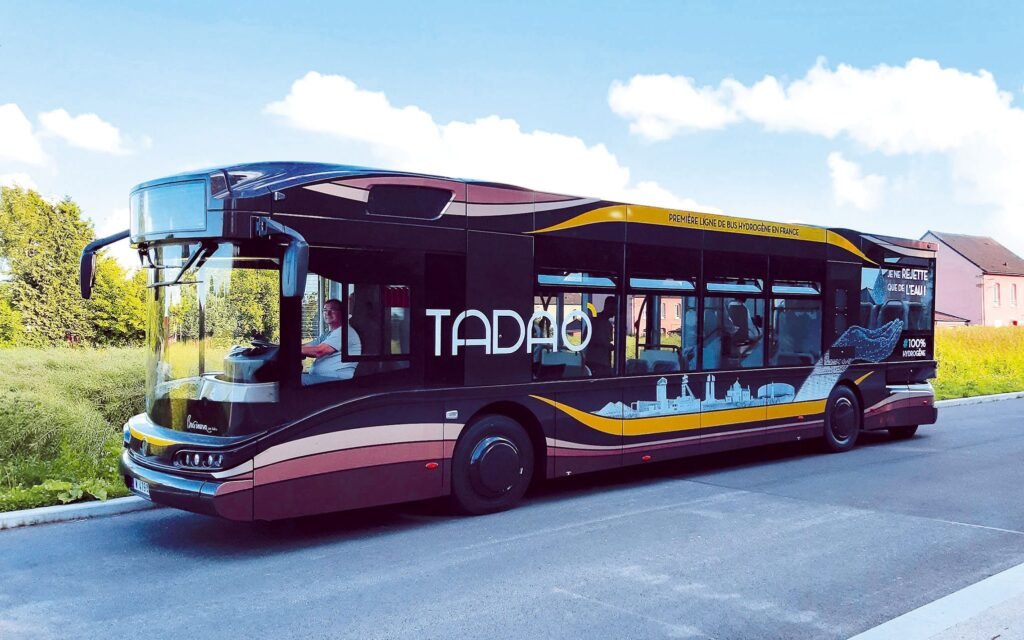Hydrogen bus lines are increasing in the country. Rapid recharge, daily autonomy, captive fleet and zero emission: hydrogen seems to have been tailor -made for the uses of urban buses. For communities as well as for private industries, it is also an opportunity to develop a local hydrogen station with a minimum amount of consumption. First lines awaiting the offer of the Union of Public Purchasing Groups (UGAP).
The first lines
The month of September saw the opening of several hydrogen bus lines after those of this summer. The cost of purchasing these buses is however twice as high as that of an electric bus. The first hydrogen bus entered service in France last June in Houdain, for the agglomeration of Artois-Gohelle, in Pas-de-Calais. The Businova H2, designed by the Albigensian company Safra, with Symbio for the fuel cell, combines an electric battery with an fuel cell which transforms hydrogen into electrical energy. Thirty kilos of this gas are stored in tanks placed on the roof. It thus has a range of 300 km per day for a charging time of only 15 minutes. Five other buses will be delivered on this line. A hydrogen production, storage and distribution station (Engie, Gnvert, MCPHY) was installed on the carrier’s website, opposite the buses maintenance workshops. The Île-de-France is experimenting for the operation of two Van Hool hydrogen buses between Jouy-en-Josas-Gare and Versailles-Chantiers (12 km), a journey taken by 1,000 travelers daily. These buses have a range of 300 km thanks to a tank of five bottles for 39 kg of hydrogen. The recharging is ensured at Air Liquide station. The objective is to test the performance of this type of vehicle: consumption, operation, maintenance costs and technical holding. This experience is funded by the Region (59 %), by the Versailles Agglomeration Community (9 %) and by the European 3emotion program (32 %).
The first Van Hool buses also arrived in Hauts-de-France, in Houdain, in the mining basin served by a McPhy service station. In Pau, the hydrogen station inaugurated in September will provide eight 18 m long bus-trans baptized Fébus. These buses will obtain supplies in a station located at the deposit with hydrogen produced on site thanks to an electrolyser powered by solar panels. The manufacturer Van Hool has already marketed around fifty hydrogen buses (32 in Europe and 21 in North America).
As part of the Hynoca project, a mixed economy company created by Haffner Energy and Strasbourg Gaz networks, a green bus project is planned in the Alsatian capital. Indeed, an industrial demonstrator of hydrogen production from biomass is announced for 2021 in Strasbourg where this decarbonized energy will make it possible to run around fifty buses daily.
A thousand hydrogen buses!
The objective of bringing 1,000 hydrogen buses into circulation in France, and therefore the construction of related production and distribution infrastructure, desired by the government in its “hydrogen plan” could become reality. The UGAP has indeed offered to local authorities who wish to work on the creation of attractive offers of hydrogen bus, the objective being that these buses become an option like the others.
Territories: Reinventing the rail
The rail infrastructures exist and serve our territories, but the train is often expensive. The taxi-rail could be a solution to keep small lines. These small modules of 40 passengers, with a range of 600 km, operating in hybrid battery/biogas or battery/hydrogen for propulsion, would also be provided with photovoltaic panels for air conditioning or heating. With a weight of 8 tonnes (10 times less than a TER), they could, thanks to artificial intelligence, define the appropriate schedules according to travelers. The prototype should be released in 2021, for a marketing planned in 2023, the year of opening up to the TER competition. Regarding the “classic”, the Alstom group should deliver 27 hydrogen trains, the Coradia Ilint, to a subsidiary of the German Transport Network Rhein-Main-Verkehrsverbund by 2022. The fuel cells are located On the roof with lithium-ion batteries in addition. Data for 160 places and a maximum speed of 140 km/h, these trains should have 1,000 km of autonomy.

